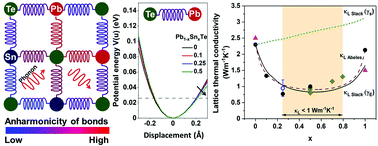Origins of low lattice thermal conductivity of Pb1−xSnxTe alloys for thermoelectric applications
Abstract
Lead telluride is a well-established material for direct conversion of heat into electricity. However, the aspects of the heat transport phenomena for PbTe-alloys remain not fully understood. Here, for the first time, origins of the phonon scattering in Pb1−xSnxTe compounds were studied through changes in the effective anharmonic pair potential obtained from X-ray Absorption Fine Structure (XAFS) spectroscopy. Results indicate that the interatomic pair potential of Pb–Te and Sn–Te bonds changes with the level of substitution x and that the anharmonicity of bonds in the solid solution is increased leading to the lower values of the lattice thermal conductivity. Furthermore, due to the existence of a soft TO mode in Pb1−xSnxTe, the Grüneisen parameter γE determined using XAFS much more precisely corresponds with the changes of lattice thermal conductivity κlat compared to γS obtained from the speed of sound measurements. This study explains the observed drastic reduction in κL in Pb1−xSnxTe solid solution (2.3 W m−1 K−1 for PbTe vs. 1.0 W m−1 K−1 for Pb0.75Sn0.25Te), due to changes in the interatomic pair potential of Pb–Te and Sn–Te and provides guidelines into its effective modification related to thermal transport in alloys based on PbTe. The estimated range of low thermal conductivity for the PbTe–SnTe solid solutions (<1 W m−1 K−1) reveals opportunities for further enhancement of energy conversion for this promising family of compounds. Moreover, this work provides a new concept for the estimation of the Grüneisen parameter through the EXAFS spectra analysis.



 Please wait while we load your content...
Please wait while we load your content...